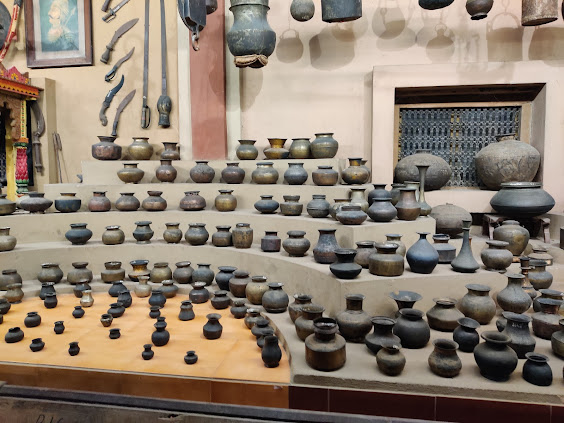Vechaar Museum: Preserving Heritage through Traditional Indian Utensils
Vechaar (Vishalla Environmental Center for Heritage of Art, Architecture and Research) Utensils Museum, located in the dynamic city of Ahmedabad in Gujarat is a singular tribute to the rich creative and cultural legacy of Gujarat in particular as well as other parts of India in general, conveyed via the means of traditional Indian utensils. The idea for Vechaar Museum came from Surendra C. Patel, who wanted to highlight and preserve India's rich heritage of domestic utensils. The museum's founders wanted to create an environment that would inspire and educate both the current and next generation in addition to housing artifacts from the past. He has always been captivated by the forms, dimensions, materials, and functions of domestic objects. He would keenly visit Ahmedabad's Sunday Market, or "Gujari," as a child. His visits inspired him to collect nutcrackers as a hobby. And with time he collected more than 600 nutcracker pieces. His hobby became instrumental in shaping his passion and acquiring further knowledge and expertise in the field. Eventually his passion and with the aid of a renowned anthropologist, Jyotindra Jain, Vechaar, a museum of its own kind in the world, was born in 1981.
The museum is open from 3:00 pm until 10:30 pm in the night and it is inside the Vishalla restaurant. The latter offers a variety of traditional meals such as thepla, rotla, farsaan, and many more that one can enjoy and learn more about Gujarati cuisine.
The museum on the other hand provides an insight into a range of utensils for cooking, serving, performing puja (ceremonial worship), for storing grains, oil, water, coconut, paan or other food items and even jewellery, for distilling perfume, for measuring rice, etc.
Visitors can also explore utensils designed for milking, storing milk and its derivatives, such as ghee, and for churning cream to prepare butter and buttermilk. From intricately carved containers to functional churns, each item tells a story of the ingenuity and craftsmanship of generations past.
If interested, one can buy books on the utensils put on display in the museum. They contain valuable information on various types of cooking and serving utensils and storage vessels and many more.
A lot of intriguing things can be experienced prior to entering the museum. There is a small section where you can see a potter making terracotta items using a potter's wheel. It features several exquisite terracotta items created by him. With his assistance, you may even attempt creating a diya (small clay lamp) or two.
A peek of Gujarati traditional wooden windows and doors, and decorative items may also be observed. Speaking of wooden windows and doors, it is to be noted here that Tanzania's Zanzibar, the "Spice Islands of Africa" had a bustling trade relationship with India starting in the early 17th century. At Zanzibar's Old Stone Town, which has been named a UNESCO World Heritage Site in 2000 one can observe the presence of finely carved wooden doors and their origins can be traced back to Kuchch in Gujarat. They were most likely transported from Bharuch to Zanzibar by sea. The Omani sultans promoted the Indian merchant groups, that had relocated to Zanzibar. They were wealthy merchants who dominated the trade in Indian cotton, Surat textiles, and goods like spices, rice, ghee, and ivory. Since the Indus Valley Civilization, India has maintained economic ties with Gulf nations like Bahrain and Oman. The commercial links between Mesopotamia (Iraq), Meluha (India), Dilmun (Bahrain), and Makkan (Oman) are mentioned in the Mesopotamian cuneiform texts.
The place also contains some examples of the traditional bead embroidery known as moti bharat, which is carried out by the women of the Meghwal, Ahir, and Rabari pastoral tribes of Saurashtra and Kuchch and it is also practiced in some places in Rajasthan, especially in Jalore.
A modest cowshed beside the museum that shelters the well-known Gir or Gyr cattle of Gujarat lends an authentic touch to the exhibits in the museum which highlight utensils for storing or making dairy products. This high yielding dairy breed's name comes from the Gir Hills in the Kathiawar peninsula, where it first appeared. And because it originated in the peninsula, therefore, it is also known as Kathiawari. Bhodah, Desan, Gujarati, Sorthi, and Surti are some other names. As the only breed in the world with an ultraconvex forehead, they have a rounded and domed forehead. Other significant distinctive features include pendulous ears and spiraling outward-pointing horns. Visitors can observe these gentle creatures and understand their importance in the dairy and agricultural industries.
Another point that should be highlighted here is that the restaurant makes efforts to keep lighting simple and minimal during the evening time which you notice as soon as you walk in. When a visitor first arrives, the art gallery, which showcases a number of beautiful paintings by Mr. Patel, instantly illuminates; otherwise, the majority of the bulbs are turned out to conserve electricity. Besides, the place also makes use of lanterns ("लालटेन") which are commonly used in villages owing to the lack of electricity. This creates a setting reminiscent of a village.













.jpg)
Comments
Post a Comment